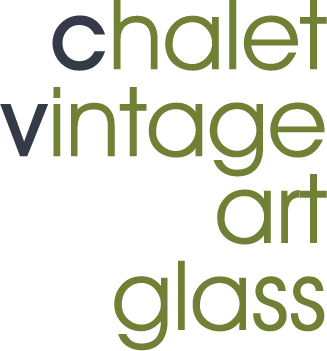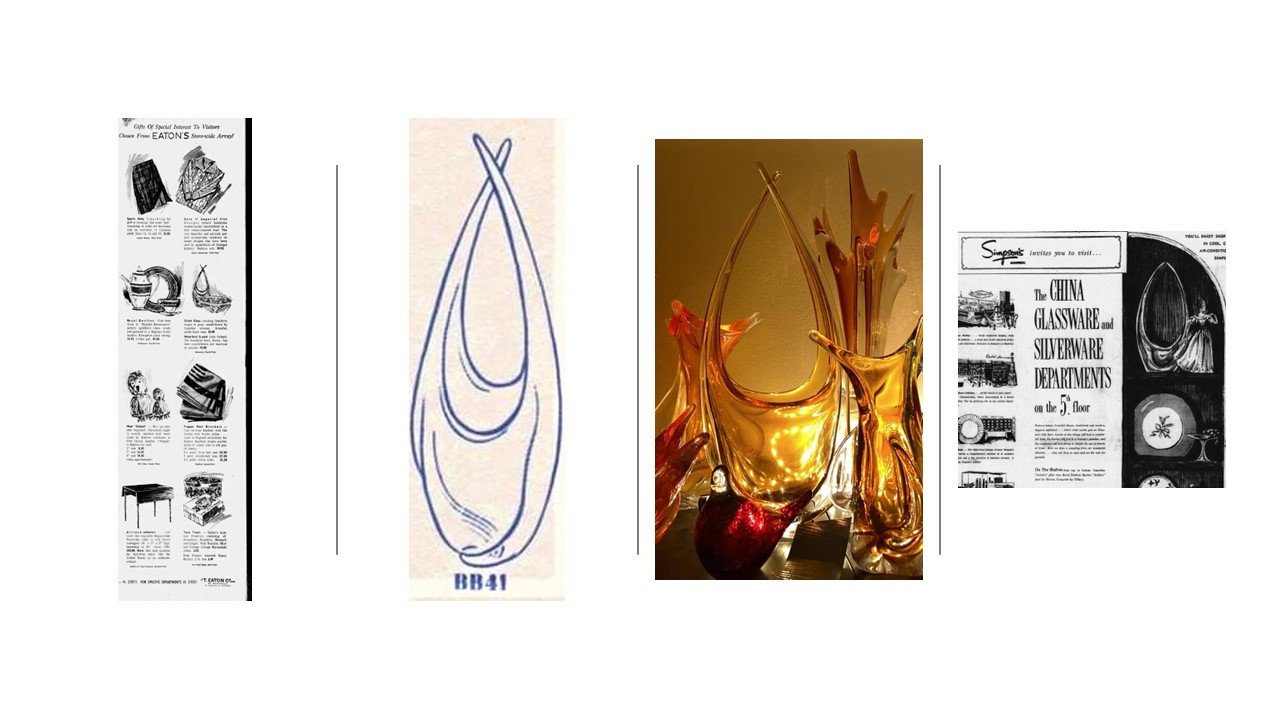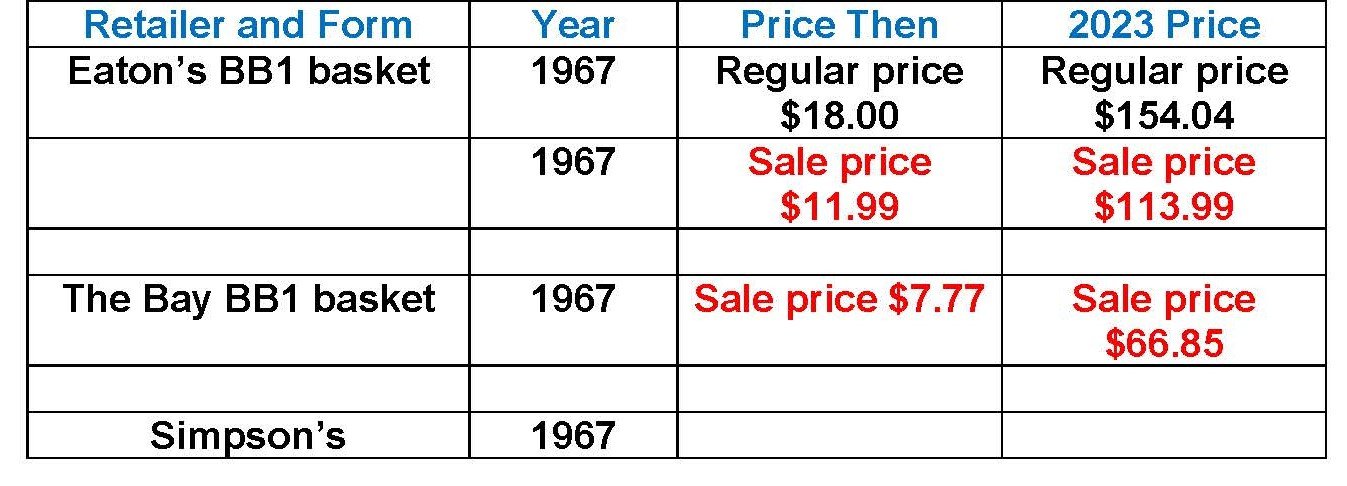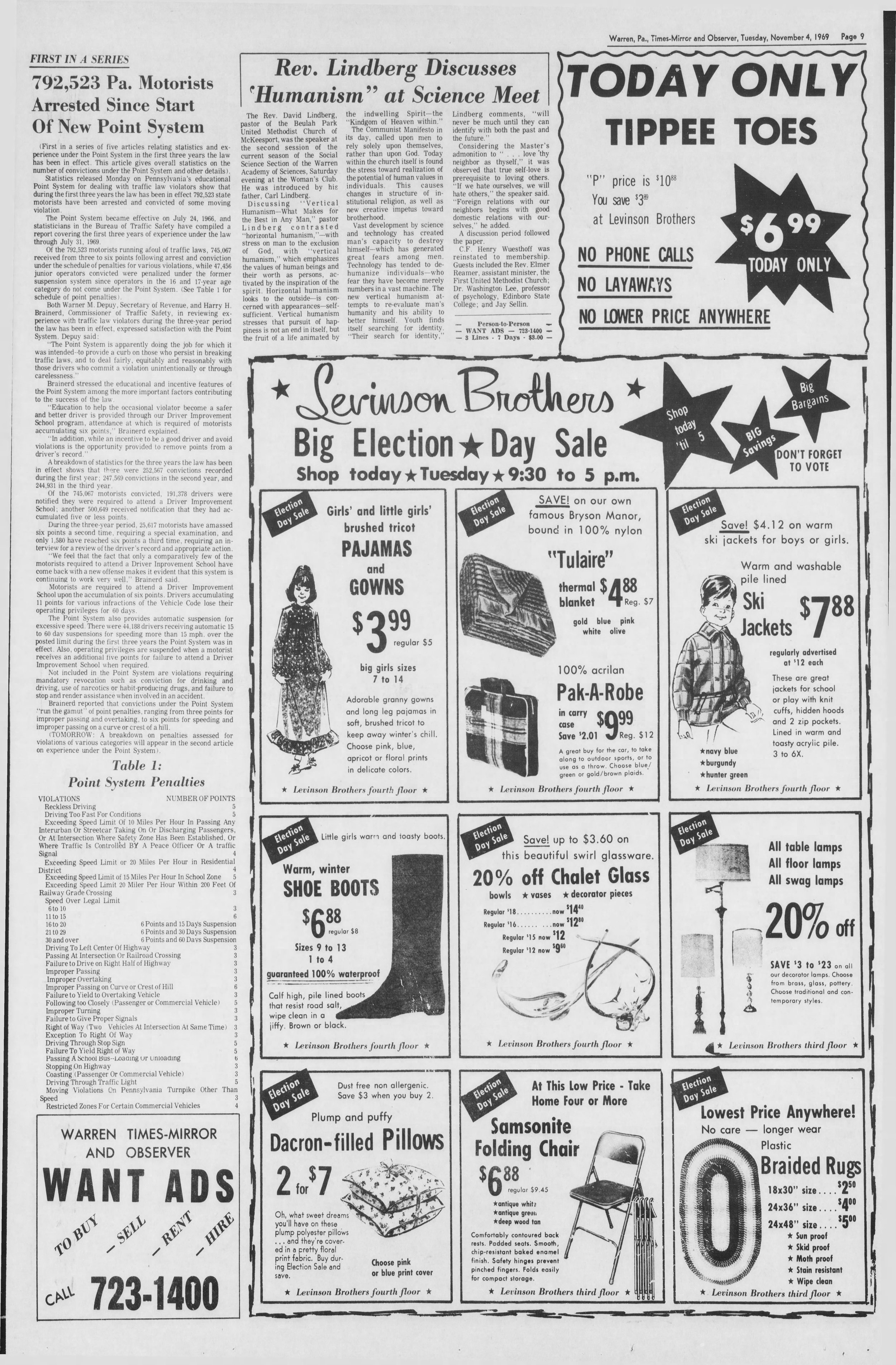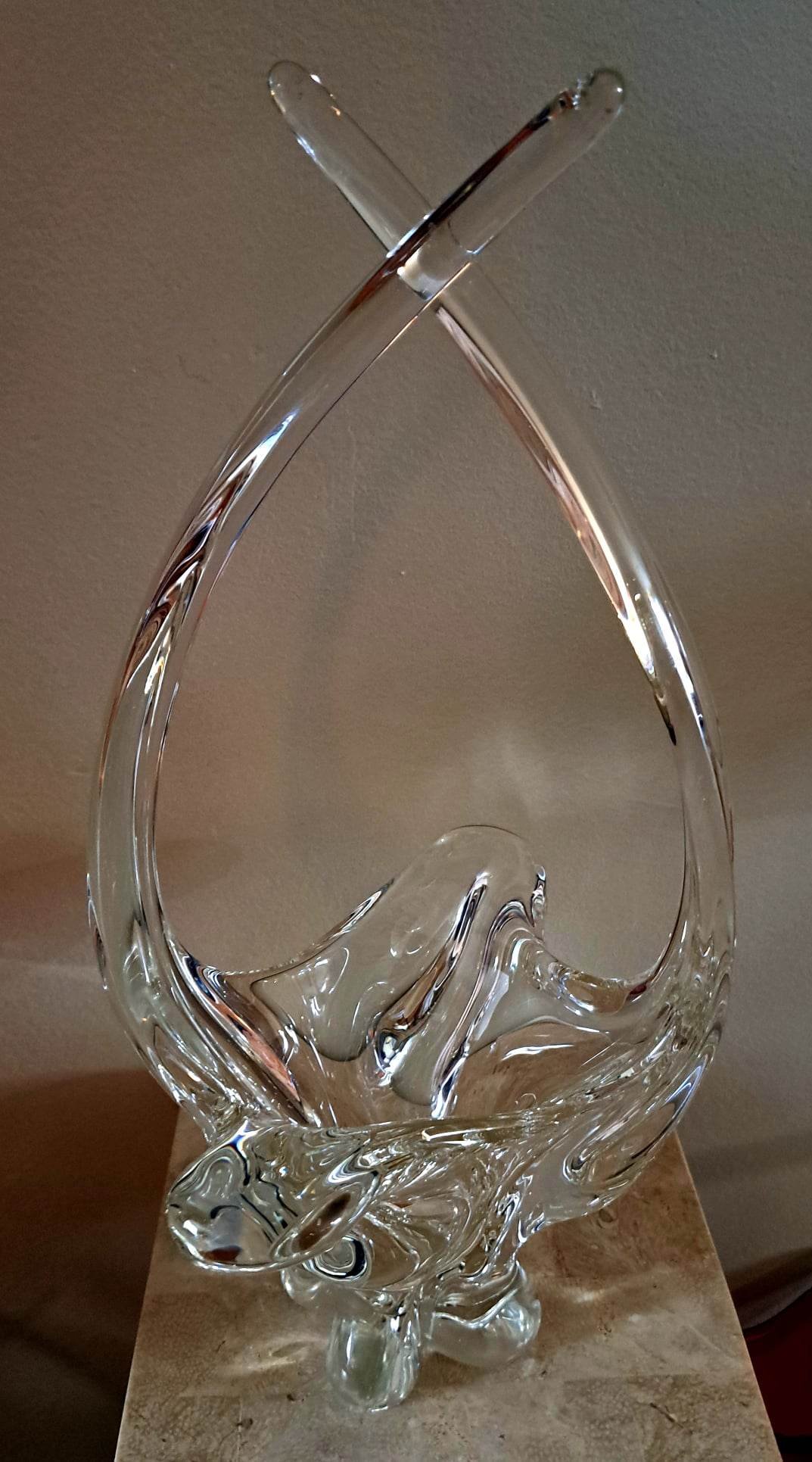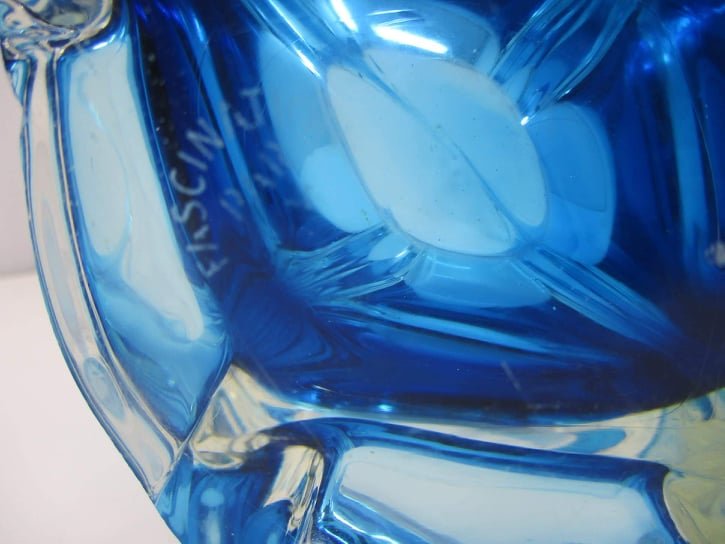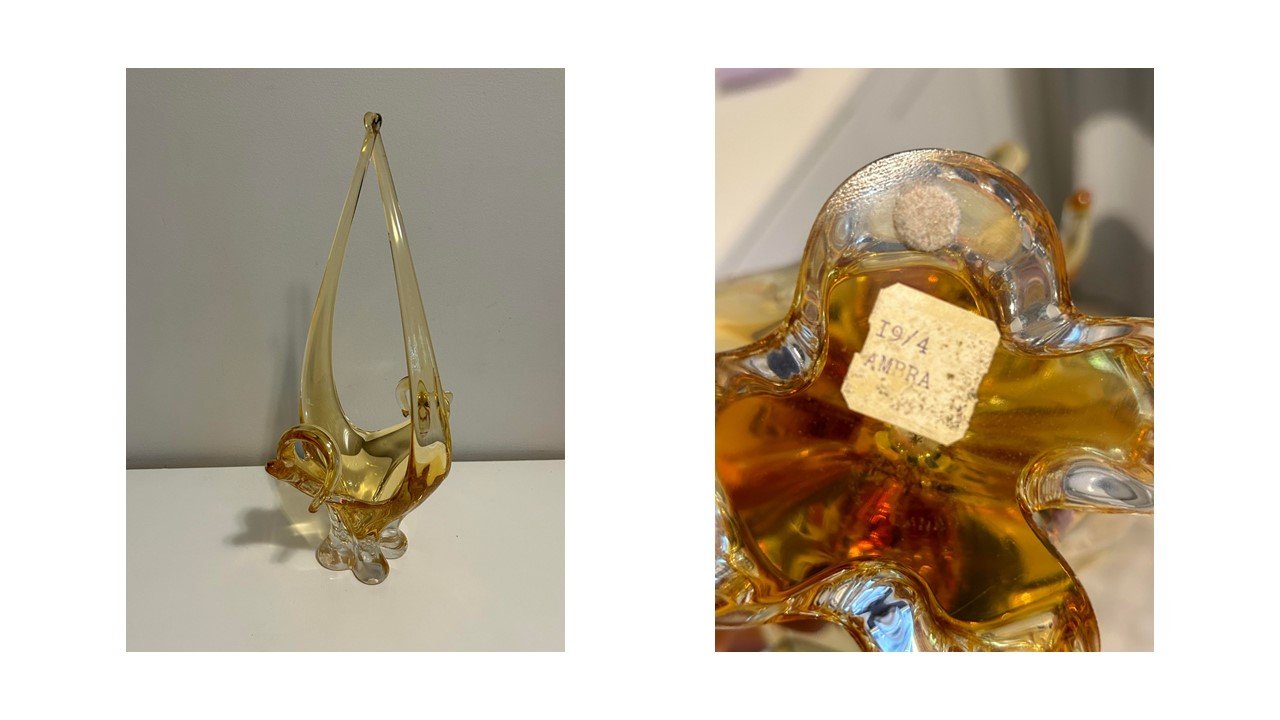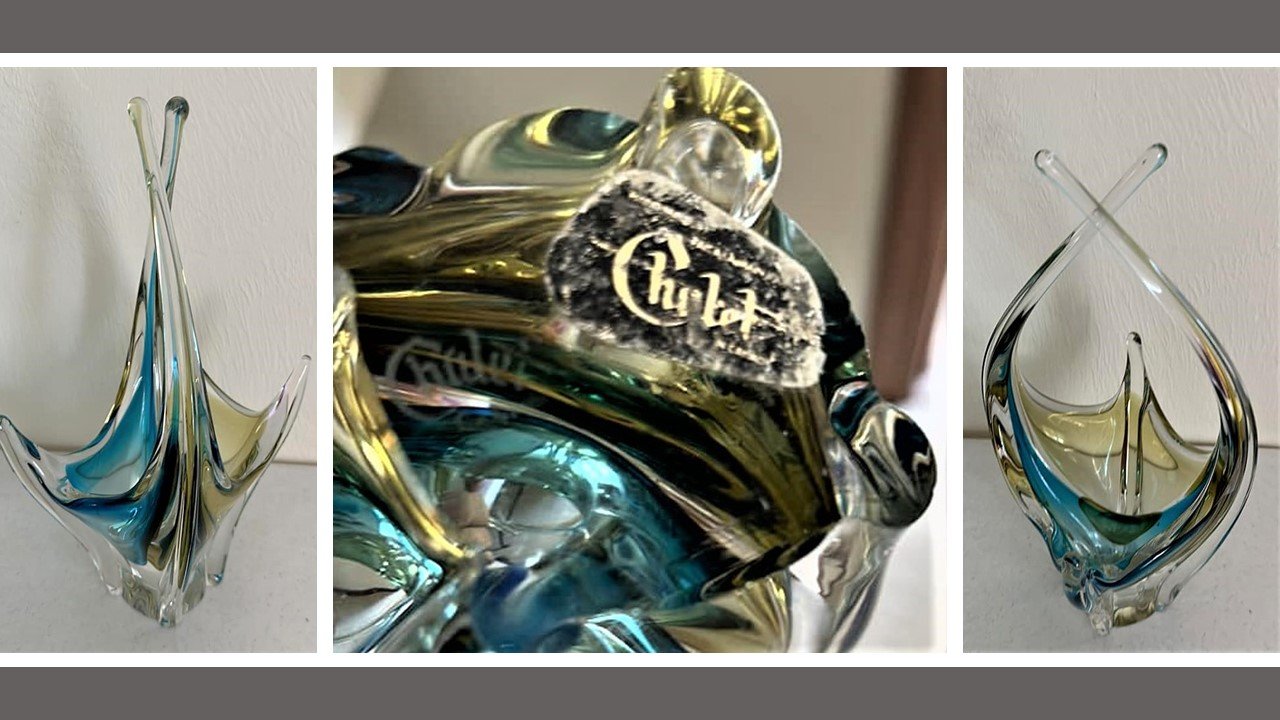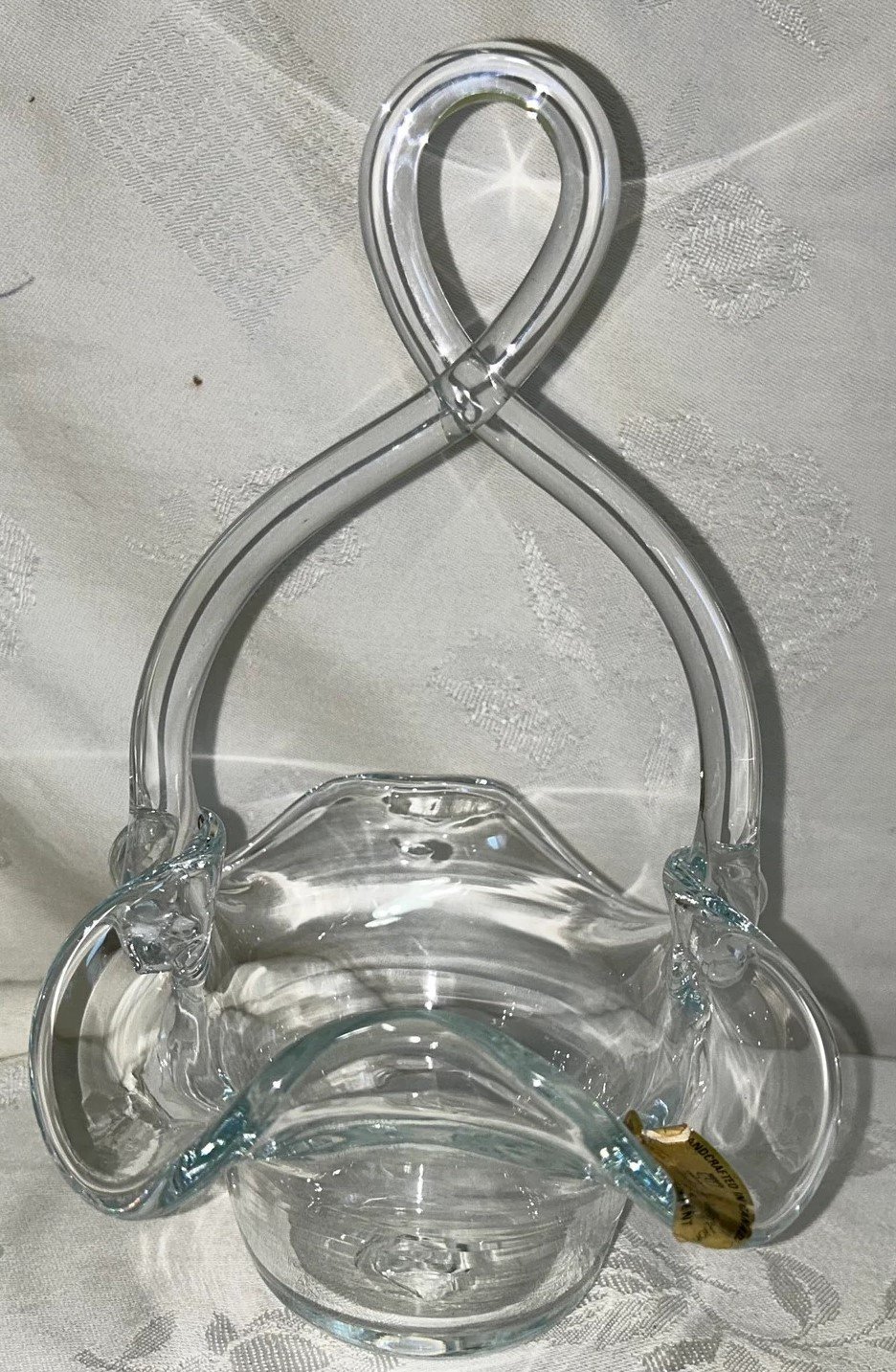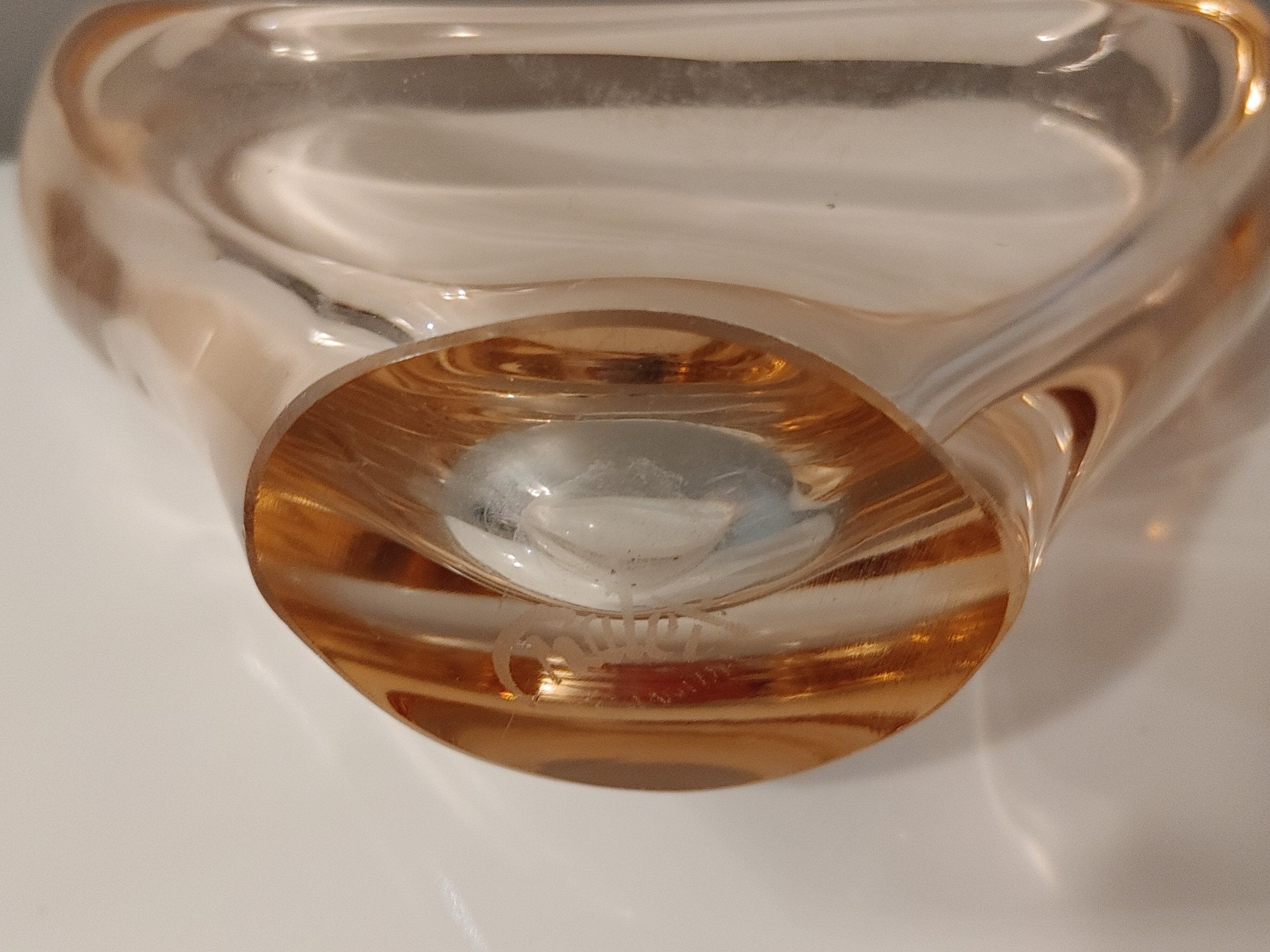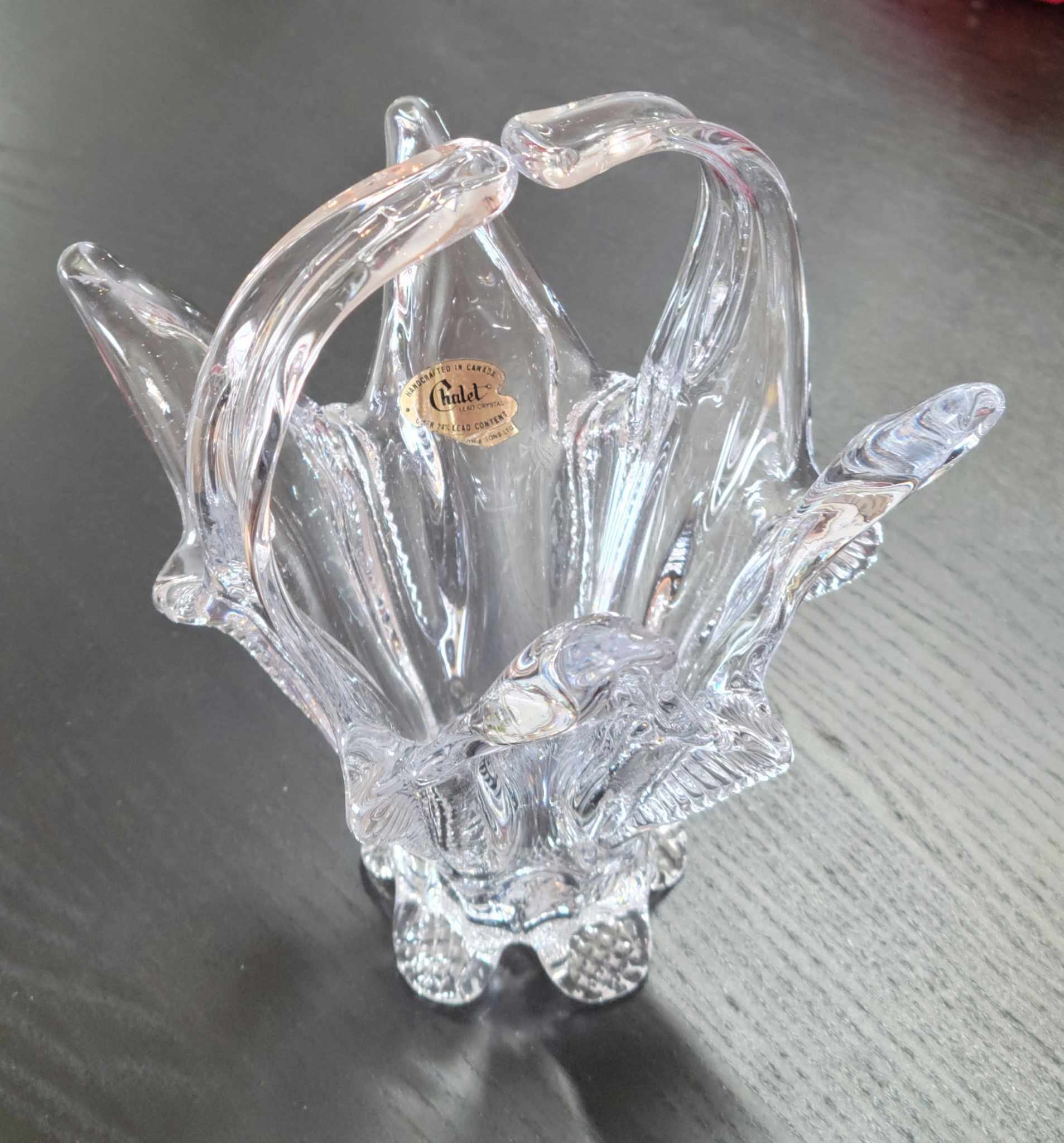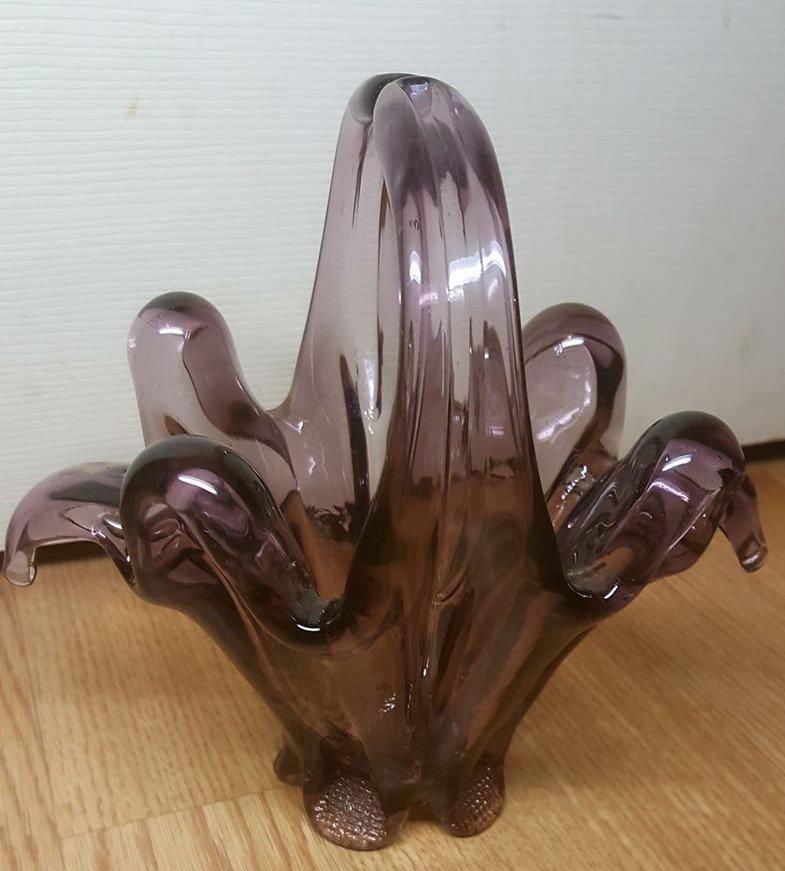A Bevy of Baskets
The initial direction for this article was to more or less just do a video of all the different styles I could gather. But, as it usually goes, I got caught up in the details as well as the visuals. End result was a full-fledged exploration!
Therefore, let’s get off on the right footing with the most basic of facts – what form do Chalet collectors call a “basket” ?
:a “basket” is a vertical centerpiece with a continuous rim (no butt indents) that elongates into tapered up-reaching “arms” (hand blown pieces) or has a vertical applied handle. The “arms” may be crossed (hand blown pieces), almost meet (hand blown pieces) or “meeting and greeting touching” (molded glass bombonierre forms). The handles on the hand blown and hand molded styles may be rounded or a “twisted rope.” The bases may be flat, footed or “petal pedestal” on the hand molded pieces.
Red hand blown “bridal basket” with flat base and “twisted rope” applied crystal handle (top left) from the collection of 50 Shades member Adam Marshall. Amber hand molded “bridal basket” with “petal pedestal” base and round applied crystal handle (bottom left) from the collection of Jude Ann Olfason. Olive 8” glass hand molded bomboniere with “meeting and greeting” touching arms (center) from the collection of Brad McGillivray. Orange basket with crossed arms and raised oval base (top right) from the collection of Deborah Patterson. Red/orange basket with “almost touching” arms and flat tapered base (bottom right) from the collection of Ella Hanks.
Chalet produced many, many forms of baskets from company start (1962) to finish (1975). However, as to be expected, there was evolution in style and changes in inventory over this period. Basket forms were done in both the hand blown and hand molded lines as well as in the bomboniere. There is a huge variety in design – this article includes 86 verified Chalet basket forms in differing styles. However, I am sure that not all have been captured here. The bomboniere were typically 3 ½”, 4” or 8” in height. Sizes of the hand-blown pieces ranged from “mini to massive” and from style to style. Some hand-blown baskets could reach 20” heights. Production sizes, however, were typically from 12” to 18”. Colours and finishes are just as diverse – solid colours, 2-tones, a 3-tone, clear crystal, cranberry in crystal, uranium baskets, baskets with the corroso, irradato and opalescent finishes… Not all are typical production pieces. We have seen quite a few “Are you sure it’s Chalet” baskets – baskets with internal dividers, millefiori inclusions and “feather” details. Bases also show a marked range of diversity from flat to tapered and from footed to pedestal. As some types of basket forms were carried universally by Chalet’s distributors and retailers, they are found with all the etchings, hand engravings, sticker and hang tags which the company used in branding their products.
A logical starting point, since we are fortunate to have some catalog sheets from Chalet, Riekes Crisa (US distributor) and FASCINATION PAR C.M. (Montreal importer and Chalet retailer) and advertising, is from this historical perspective.
Three of the earliest styles of baskets are found in the 1962 Chalet Artistic Glass “Items Available” catalog sheet:
BB41 (illustrated at top right) from the “Items Available” catalog sheet above:
Both of the advertisements included here are from national chain retailers that carried Chalet product. The ad on the left is an Eaton’s (Chalet’s first national carrier in early 1963) and the price is $20.00 which translates into a 2024 cost of $199.75. Since the average hourly wage for males in 1964 was $2.21 and under $2.00 for females, you can see how “pricey” this would be. The 1963 ad on the right is from Simpson’s and is very interesting as the glass is misidentified as Lorraine. Many of Simpson’s ads wrongly attribute the makers as both Chalet and Lorraine inventory were carried by this chain as well as by Eaton’s and Morgan’s/The Bay. However, usually, the Lorraine is identified as Chalet. This early Chalet form is a basket from the collection of 50 Shades member Daniel Lynch. Both of these promotions were featured in the Montreal Gazette which is a division of the Postmedia Network.
When I interviewed Patricia O’Connell (woman with basket in this photo shoot) regarding her connection to Chalet, she told me: “I met a photographer at a party and he asked me if I wanted to do a photo shoot for some glass. I had never heard of Chalet – I was just a pretty girl at the right place and time.” Newspaper article from the Ottawa Citizen, January 17, 1964. This newspaper is a division of the Postmedia Network.
Another Simpson’s advertisement wrongly attributing the glass maker. 1966 advertisement from the Ottawa Journal.
BB44 (illustrated at middle right) in the “Items Available” catalogue page above:
February 18, 1963 Postmedia Network’s Montreal Gazette. Once again, this is an Eaton’s advertisement. The basket is described as “... amber and about 19” high” and is priced at $12.00. Minimum average hourly wage for men in 1963 was $2.12. In 2024 dollars, the cost would be $119.85 and the minimum wage was $16.75. So, you would be working about 7 hours in both past and present to add this piece to your collection. BB44 basket from the collection of 50 Shades member Dwain Robertson.
In other colours, from the collections of 50 Shades members – Dwain Robertson (blue), Iam Marc Linder (olive) and Bruce Budden (orange).
A BB44 variation:
Although this basket is quite similar in form, sharing many of the characteristics of the catalogue BB44, it is definitely a variation in style. The lack of pointed crystal side pulls is the most notable difference. From the collection of Deborah Patterson.
A very rare BB44 variation:
Photograph courtesy of 50 Shades member Jacques Binette. This form has also been seen in blue.
BB1 (illustrated at lower left) in the “Items Available” catalogue page above:
Both these advertisements are from Ottawa retailers. The middle ad (courtesy of 50 Shades member Gionny Gueli) is from Ogilyv’s (a high-end independent, Ottawa department store 1887-1984) and ran in the 1963 September 6th edition of the Ottawa Citizen (Postmedia Network). The ad in the bottom right is from the Ottawa gift store chain Davis Agency which was founded in 1945 and still operates as Hallmark franchises. This promotion was also run in the Ottawa Citizen but on November 20, 1964. It advertises small baskets at a cost of $9.00 and large at $12.00. In 1964, the average hourly wage was $2.21. Basket from collector Daniel Lynch’s collection.
An early BB1 with the surface corroso finish:
This finish results from washing or submerging a piece in acid at the final stages. The polished finish is obliterated – replaced by a dull, etched finish in its place. However, the glass will remain transparent. All the corroso finished Chalet pieces that have been found, at present, are pink.
An early BB1 Variation:
Note the subtle variations – the overall shape of the basket is more tapered as well as slenderer and the middle pulls are more vertical. Amber basket is from the collection of 50 Shades member CT Young.
The BB1 basket style continued into later production years. Indeed, it is the most common Chalet basket style found by collectors and the most frequently advertised. I have dozens of advertisements from 1963 onwards in which it is featured.
However, there were some significant evolutions in form – namely the base. I asked Maestri Panizzon and Gatto and Chalet artist Gianfranco Guarnieri about this when I interviewed them for “The Shapes and Colours of Chalet Glass ” in 2011. Their answer was simple and spoke to “function over form”: “We needed something better to hang onto.”
Note the base differences. The red/orange basket at rear has a less defined and more organic profile. The olive basket at front has a definite footed base. Seeing the two together like this really emphasizes the point the artists made above. This lovely set from the collection of 50 Shades member Ella Hanks.
Chalet catalog sheet showing the later (footed) BB1:
The BB1 basket is shown here with 2 heights and with the 16” height designated as “SS.” However, there is a second catalog page where a BB1XS at 14” is shown with basket style BB5 (see below). The quality of that page is not very good as the base details obscured but I believe the difference to be simply another height designation, not a variation in style, given that we see here that the 16-inch basket is given letters as well. Perhaps Chalet started out producing this basket in only two heights and then quickly added a third? Perhaps responding to market demand for a smaller version?
The red BB1 basket is from the collection of 50 Shades member Jay Hutton.
Both the early and later styles of basket form BB1 were carried by many, many distributors and retailers so they are found with a variety of markings. Advertisements for this piece have been found from national resellers such as Eaton’s, Simpson’s and The Bay/Morgans.
These 3 advertisements are from the year 1967. Eaton’s promotion (at left) is from the Edmonton Journal on September 16th. The Bay ad (middle) was run in the Star Phoenix (Saskatoon) on September 26th. The Simpson’s advert at right ran in the Leader Post (Regina) on July 14th. And, once again, you will note a mistake. Chalet is called not even Lorraine here but Blue Mountain Pottery! These three newspapers are owned by the Postmedia Network.
Even with sale prices, there was a significant difference in the cost of purchasing a BB1 at Eaton’s compared to a purchase of the same basket at The Bay.
No price was listed specifically in the Simpson’s ad for the BB1 basket shown. The copy reads “…scores of forms…” and a price range from $7.00 to $20.00 is quoted.
Localized and regional chain retailers such as Davis Agencies (Ottawa), Woodward’s (department store chain in Alberta and British Columbia), MacKenzie’s (jewellery store chain in Alberta and Saskatchewan) and Reed’s China and Gift Shop (chain in Calgary and Edmonton) also carried this form on a long-term basis.
The Reed’s ad at left was run in the Edmonton Journal on January 5, 1966 in the Edmonton Journal. The MacKenzie’s promotion (middle) was featured in the April 18, 1968 edition of The Leader-Post in Regina. At right, this Woodward’s advert is for their Victoria location in British Columbia and was run in the Daily Colonist on July 20, 1965. All these newspapers are part of the Postmedia Network.
BB1 was also carried by single storefront retailers such as Ogilvy’s in Ottawa (as shown above) and DuPuis in Montreal.
This Quebec department store advertisement for their Chalet inventory ran in The Gazette on July 13, 1965. The Gazette is a division of the Postmedia Network.
The BB1 basket, as well as other Chalet product, was featured in the Eaton’s catalogs as well as their newspaper print advertising:
1968. Middle inset from catalog courtesy of 50 Shades member Lorraine Hawley.
By far the most interesting advertisement I discovered was the following one from 1969. Why? It is from an American retailer, the Levinson Brother’s Department Store, Warren, Pennsylvania:
This ran in the Warren Times Mirror and Observer on Tuesday, November 4, 1969.
As stated above, the BB1 baskets are found with many different markings. An example of just three of those hallmarks:
The olive basket bears the etched “Chalet Canada” signature, the orange retains the large Chantili sticker and the blue bears the Eaton’s branding. BB1 baskets with the etched Chantili signature have also been found.
One of my all-time favourites:
This exquisite and exceptionally rare BB1 basket from the collection of 50 Shades member Cindy Bishop Loughlin.
A one-of-a-kind unusually coloured Chalet BB1:
This etched “Chalet Canada” basket is from the collection of 50 Shades member Jonathon Tremblay.
There have also been a very few 2-tone BB1 baskets found:
Lucky 50 Shader Jo Highland owns the basket on the left and Dwain Robertson owns the basket in the middle.
And this even more rare 3-tone:
I originally found this basket for my mother, Grace Woods. It now belongs to collector Kelly Berndht.
The BB5 (top left in the following Chalet catalog page) basket:
At right, note the 14” BB1 basket with the letters “XS” indicating this was the smallest version – see above for the catalog page where the other BB1 heights are presented.
There is no record of production time lines regarding the BB5 basket. However, note that this style of basket does not have a distinctly footed base. To date, we have not found this exact catalog style in solid colours. Just a 2-tone and the uranium. However, there are variations of this style in solids.
2-tone BB5 basket in middle with uranium baskets flanking.
Two very rare variations:
These baskets are much smaller and the base is more obviously footed. The olive basket on the right has a blue coloured base, very rare for Chalet, and is etched with the Montreal importer/retailer FASCINATION PAR C.M.’s signature. Its body shape is much more graceful and the rim has a downward slope to the middle.
The more commonly seen variation:
To date, we have seen this basket in only a 12” height. It was produced in the typical Chalet production solid colours but we have found some rarer solids (cranberry and purple) as well as a blue/green and a red/orange 2-tone. Note that the base is a flattened, raised oval pedestal.
Blue/green basket on left from the collection of 50 Shades member Michael Flink.
Another rare variation:
The base on this small 2-tone blue/green basket is higher, more rounded and tapers upwards. It has no oval pedestal nor is it footedThe basket “arms” are also much more rounded. From the collection of 50 Shades member Dwain Robertson.
Chalet catalog page for the “Cranberry in Crystal” basket. Inventory #’s 13106, 13107 and 13108:
Typically found etched “Chalet Canada.” This is a large, heavy basket. As illustrated in the photograph at right, there is some variation in the body shape from piece to piece. Colour placement is fairly consistent.
See top left for this basket style. A Chalet company run 1971 advertisement from the Cornwall Standard Freeholder which is operates as a division of the Postmedia Network. Courtesy of the Cornwall Community Museum.
A huge surprise in this style:
Uranium in the clear crystal throughout this piece! From the collection of 50 Shades member Lisa Han Xiaohong.
This style was also carried by Riekes Crisa in the United States. A Chalet company press release:
1973 Chalet press release. Basket is in the photograph at left in centre row. Photograph at top right – from at left Chalet artist Angelo Rossi, middle Riekes Crisa executive Roger Burns and at left Chalet founder, owner, chemist Maestro Sergio Pagnin. Please note that Chalet spelled “Reikes” wrongly throughout this advertisement! Courtesy of the Cornwall Community Museum.
Chalet catalog page for the large “hoop” BB2 basket:
The 2-tones in this style that have been found:
Although both are 2-tones, these BB2 forms bear different markings.
This basket bears the exceedingly rare Birk’s label as well as being etched “Chalet Canada.” It is more common, although still very rare, to find Chalet pieces that are etched with the Birk’s initials or retain a Birk’s inventory label. This piece was on display at the 2010 Chalet exhibit in Cornwall, Ontario.
The Birk’s marked BB2 basket (far left).
Bearing the iconic Chalet hallmark.
Favourites from the collection of Dwain Robertson.
The BB2 has also been found in clear crystal:
As you can see, the base of this BB2 basket is etched “Chalet Canada.” It has also been found with an N. C. Cameron and Sons Ltd sticker.
I was given this original FASCINATION PAR C.M. catalog sheet featuring the Chalet product that they retailed from Chalet Maestro Giulio Gatto:
See basket in top row #70702 (middle right). This basket was also distributed by Chantili and has been found with Chalet Canada markings as well. It is a fallacy that any one distributor or retailer had “exclusive” rights to sell or distribute any one Chalet product. Moreover, no one line/form/colour was created for just one distributor or retailer.
Basket in middle from the collection of Deborah Patterson and is etched “Chalet Canada.” At top right and bottom left, baskets belonging to 50 Shades’ Kevin Hall and the basket at bottom right is owned by 50 Shader Cindy Bishop Loughlin. It is etched with the Chantili signature.
An ad featuring this basket style in a 1968 Mother’s Day promotion for “…Exquisitely hand wrought Chantili…” was run by Walkers in the Kitchener Waterloo Record on May 9, 1968. This newspaper is operated by the Metroland Media Group, a subsidiary of Torstar Corporation.
Although this “curly” style of basket is not shown on any of the catalog pages of which we are currently aware, this particular piece retains an inventory sticker on its base with the designation of “I/9 4.”
This style has been found with both the “Chalet Canada” and Chantili etchings. From the collection of 50 Shades member Alex Wicks.
As above, gold basket belongs to Alex Wicks. The blue in the bottom left photograph is from the collection of Roger Lambert. The middle red belongs to Dwain Robertson. Top right orange piece belongs to Rose Mundy and the unusual salmon coloured basket at the bottom right is from the collection of Cindy Bishop Loughlin.
Photograph on left shows a “curly” variation:
Basket at left is etched Chantili while basket at right is etched “Chalet Canada.” The Chantili basket’s base has much less obvious “feet” and there is a side “antler” pull.
This design has also been found etched “Chalet Canada”:
The larger purple basket, this same “curly” variation style, bears the iconic Chalet signature. To date, these 2 baskets are the only ones of this style of which I am aware.
Olive green/sapphire blue “divided” baskets:
We know from Chalet artist Tony Tedesco that these rare baskets were made by Maestri Sergio Pagnin and Luigi Tedesco. They were also Chalet founders and owners.
From the collection of 50 Shades member Patrica Wright.
From the collection of Deborah Patterson.
“Tornado” base baskets:
Basket at left from the collection of 50 Shades member Gionny Gueli and at right from the collection of 50 Shades member Mirielle Boudreau.
The hand-blown Chalet with applied crystal handles baskets:
Applied crystal handles and “bridal” basket styles were not exclusive to the hand molded lines. Indeed, two styles of hand-blown bridal baskets and several other styles of baskets with applied crystal handles are quite frequently found. The bases of all these styles are flat and polished. The handles can be surface textured or not and can be either a rounded arc or a more vertical “twisted rope.” They are applied at end stage of production. The decorative handle attachments are also crystal. Their designs can be the Maestro Sergio Pagnin designed “face prunt”, a curled or flat leaf or a raised “raspberry/rosette.”
The styles of hand molded baskets with applied crystal handles styles of baskets are found in the whole range of the Chalet colour kaleidoscope and were produced in cranberry and clear crystal as well. Markings are most typically the small gold foil Chalet “lead crystal” sticker, the “Chalet Canada” signature or the Chantili etching. However, as the hand-blown baskets with applied crystal handles were also distributed by Tex Novelty and N. C. Cameron and Sons in Canada and by Riekes Crisa in the United States, we have also found a scattering of those brandings.
The catalog page featuring the Chalet BB204 “bridal” basket:
Chalet Maestro Giulio Gatto also gave me this catalog page.
BB204 basket from the collection of 50 Shades member Adam Marshall. This catalog form is much less common than the second style (shown directly below). However, I have no catalog number or reference for the second style/variation that follows.
A hand blown “bridal basket” variation:
From the collection of the Zhao family, this etched “Chalet Canada” hand blown “bridal basket” is a very typical example of this style and much more commonly found. The obvious differences from the basket BB204 style above are that the rim of the basket bowl is not scalloped and the handle is not the vertical “twisted rope.”
The blue basket on the left, from the collection of 50 Shades Jay Miller, is etched with the Chantili signature. The gold basket at right retains its small gold Chalet “lead crystal” label. It has also been found in red.
A striking variation in the leaf detail handle attachments:
Note that the handle attachments are coloured – not clear crystal. Another amazing piece from collector Kevin Hall.
Cranberry hand-blown baskets with applied handles:
Four different styles of hand-blown cranberry baskets with applied crystal handles. These are found with a variety of markings – the Chalet “Canadiana Cranberry” hang tag, the N.C. Cameron and Sons label (middle right) and the “John Riekes Collection” sticker (far right).
Basket above at far right is shown in the 1976 Riekes Crisa General catalog.
A clear crystal hand blown basket with an applied crystal handle:
Retains a John Riekes sticker.
A solid colour hand blown basket with applied crystal handles:
Retains a Roy Craft distributor (Montreal) label. Another unusual basket from the collection of Kevin Hall.
“Feather” baskets:
A large style of basket that, if unmarked, is often misidentified as EDAG because of the middle pulls that resemble feathered wings. Chalet did produce other pieces with feather/wing details as well.
This form is typically etched “Chalet Canada.” From the collection of 50 Shades member Susan MacDonald.
The “feather” basket has also been found in olive, amber and blue.
The blue “feather” basket at left in foreground is from the collection of 50 Shades member Robert Rigo Nitschmann. Please note that the blue basket at right in rear is an EDAG piece. Photo of orange basket courtesy of Ryan Shawn Robertson. Olive “feather” from the collection of Deborah Patterson.
A variation:
Similar yet different! Base is footed – not flat. And, although this form does have middle “wing” pulls, they do not have the “feather” detail.
Another example of Chalet “wings and feathers”. This centerpiece is also etched “Chalet Canada” and is from the collection of Deborah Patterson.
Unique and lovely!
The side cuts on this glowing basket are much deeper and thicker than typical. Etched “Chalet Canada.’ Photograph courtesy of 50 Shades member Cathy Antonyshyn. Now in the collection of Deborah Patterson.
Rare, rare, rare, rare… Chalet baskets with millefiori :
Meaning a thousand flowers in Italian, millefiori pieces are produced by first heating a bundle of thin glass rods of different colours until they fuse. Next, this bundle is pulled thin, cooled, and sliced cross-sectionally to produce small disks with flowerlike designs. These disks are applied to hot hand or mouth blown glassware (most typically vases, bowls, baskets, and paperweights) which is then reheated and worked again. The result is a brilliantly coloured piece of glassware with an intricate, fade-resistant ornamental design. These are the only Chalet baskets with millefiori of which I am aware. The basket at right is yet another jaw-dropper from the collection of Kevin Hall. A closeup of it:
Chalet uranium baskets:
Uranium oxide, when suitably prepared, produces colours of great vividness. First used by artisans in pottery glazes and glass. Antique glass that contains uranium is often referred to as “Vaseline Glass.” A nickname given in the 1920’s to pieces that glowed as there was a perceived resemblance to petroleum jelly.
Commercial usage in Canada of uranium was off and on again up to 1968 – supply was determined most often by catastrophic world events. It was widely used before World War 1 and then banned but following World War 2, usage of uranium in civilian productions was again allowed. As a result, during the 1950’s, there was a great boom in uranium mining in Canada - we were and are the greatest producers of uranium in the world. However, due to the health and environmental risks associated with uranium and disposal of its waste, in 1963, the U.S and Great Britain declared a moratorium on widespread uranium use in civilian applications. The risk to the workers was not only through inhalation and ingestion but through dermal contact and injury – something to which glassblowers are prone. Debate in Canada regarding these same issues began in 1967 and ended in 1969 with the same moratorium. France allowed civilian use of uranium until 1980 and, some countries, like China, still allow uranium use in the production of goods such as glassware.
Chalet Artistic Glass was registered with the American government’s Nuclear Materials Management and Safeguards System because of the company’s use of depleted uranium in its glass – a fact of which the Chalet artists were unaware.
Chalet stopped using uranium, along with several other ingredients, with the Canadian government ban. Therefore, we have a way to broadly date when the Chalet pieces containing uranium were produced – 1962-1969. EDAG also produced pieces which contain uranium. Of particular note – you will find EDAG aqua uranium pieces. To date, we have found no evidence that Lorraine Glass Industries produced pieces with uranium.
Chalet “fire” uranium basket styles.
Chalet “ice” uranium basket styles. You will note that the style in the picture at far left was not shown above in the “fire” uranium gallery. To date, I have no photographs of that style in the red/orange uranium. Basket at far right from the collection of 50 Shades member Jack Sibbers.
Another unusual style:
This basket is etched “Chalet Canada.” I think it is say to say that without the signature, it could easily be misidentified as a Lorraine Glass Industries basket
Chalet “mini” baskets:
Chalet minis were not production pieces. They are also not sales samples. They were done in a limited range of styles to use up materials at shift end. They may or may not be marked.
The “hoop” arm is the style of Chalet basket “mini” that is the most common:
With the exception of the pale blue “piccolo”, these Chalet cuties are from the very extensive collection of Dwain Robertson.
A rare variation:
A rare form in a rare colour. Etched “Chalet Canada.”
From the collection of Deborah Patterson. All etched “Chalet Canada.”
Piccolo versions of production sized baskets are very occasionally found:
From the collection of Melissa Patterson. Mini retains its N. C. Cameron and Sons Ltd. sticker.
A BB1 mini with her big sister. From the collection of 50 Shades’ Christine Mantler Spain.
Baskets were also done in all of Chalet’s hand molded lines. Chantili and N. C. Cameron were the major distributors of these lines in Canada. In the United States, Riekes Crisa was the major distributor for these pieces.
1973 press release.
“Canadiana Cranberry” baskets:
This basket was marketed in both Chalet’s “Canadiana Cranberry” and “Canadian Heritage Glass” lines (see below). This Eaton’s Mother’s Day campaign ran May, 1971 in the Edmonton Journal which is part of the Postmedia Network. It is a significant advertisement as it introduced “Heritage by Chalet Glass.” The first proof of Eaton’s carrying forms from any of the four hand molded Chalet lines.
Riekes Crisa catalog page showing hand molded cranberry Chalet pieces. Eight different styles, seven here plus the hand blown one shown above, are featured:
The 1976 catalog page with the “Chalet Collection” of cranberry baskets. Riekes Crisa did not use the “Canadiana Cranberry” branding.:
American retailers carrying Chalet product through Riekes Crisa distributorship:
MOHR VALUE was a 20-store retail chain in Illinois and Missouri. It was sold to Walmart in 1977. Their ad, at left, was from a Missouri location in 1973. In middle, still operating today, Boscov's Inc. is a family-owned department store chain with fifty locations throughout Pennsylvania, New York, New Jersey, Delaware, Ohio Maryland, Connecticut, West Virginia and Rhode Island. This particular advert was for the Boscov’s in Lebanon, Pennsylvania in 1973. Richmond Gordman was a large department store chain founded in 1915 and operated until 1992 with locations in 19 states. This 1974 advertisement 9at right) was for their Omaha, Nebraska location – coincidentally, headquarters for Riekes Crisa.
The later undated Riekes catalog, after Chalet’s closure, now presents their remaining Chalet cranberry inventory as ‘American Cranberry”. There is no mention of Chalet.
Note the Chalet bomboniere and sailboats as well. The bells shown here are not the Chalet for Riekes bells nor are the small clear baskets Chalet made.
“Canadian Heritage Glass” baskets:
Amber hand molded “petal” pedestal footed “bridal basket” at far right from the collection of 50 Shades member Gionny Gueli.
This basket is also from the collection of member Kevin Hall.
Surprisingly, I have very few Canadian Heritage Glass baskets, as compared to the multitude of vases, pitchers, bowls, and centerpieces from this line, on file. This indicates two things:
:that fewer numbers and styles of baskets were made in this line
:and/or that fewer survived
Moreover, I also have no catalogue pages in which they are featured. However, I do have a second Oglivy’s (BB1 basket shown in an Oglivy’s ad earlier) advertisement from the May 26, 1972 edition of the Ottawa Citizen. It is promoting “Canadian Heritage Glass by Chalet Artistic Glass in Subtle Laurentian Green” and mentions a “…Large 9” basket”. This newspaper is a division of the Postmedia Network.
“End of Day” baskets:
Distinctive with their opaline and cranberry overshot, artists started working these pieces by blowing clear crystal molten glass into a mold. Pieces were then finished by hand working “overshot” – a piece would be rolled over a steel plate which was covered with thousands of exceedingly small shards of both cranberry and opaline glass. The shards adhered to the larger gather of glass. These glass slivers were very sharp – sharp enough that they could cut hands at the slightest touch. The piece was then returned to the oven and re-heated which melted the small pieces of glass. This melting caused them to lose their sharpness. It was then worked by hand into a desired shape. This produced a separation between the pieces of glass. The spacing of the opaline and cranberry adds varies from one piece to the other, depending on the size of the piece. The finished surface of the glass is smooth but textured and the cranberry remains distinctive from the opaline glass.
Chalet’s naming of this line is tongue-in-cheek. Usually an ‘end of day’ reference in glass refers to random pieces made from materials that remained at ‘end of day.’ However, Chalet’s “End of Day” line was scheduled production work and pieces were produced within those parameters and not at random. These pieces are typically found with a Chalet Canada sticker or the 4-sided gold and red N.C. Cameron and Sons hang tag or this distributor’s silver sticker.
Note the nicely textured surface on this basket from the collection of 50 Shades member Marcus Wharton. Applied handles could also have a completely smooth surface.
“Opal with Cranberry splatter” baskets:
These baskets are also hand-molded and share some commonality with Chalet’s “End of Day” pieces in that opaline and cranberry are used. However, Chalet used opaline and cranberry in these 2 lines very differently. For this line, the Chalet artists blew opaline, not clear crystal, glass into a mold. In addition, at end, a fine cranberry powder, not cranberry glass shards, was spread on steel sheets. The pieces were then carefully positioned and rolled in this. As the pieces turned, the “splatter” effect was achieved. Limitation of cranberry application was deliberate as Chalet wanted this line to be totally distinctive from the textured “End of Day” line. The “splatter” pattern and colour vary from one piece to another. The finished surface of the glass is smooth not textured but the sides of the piece and its base retain the mold markings.
The marking for this line is a bit confusing. In Canada, it was distributed by N.C. Cameron and Sons so was often given the same hang tag as the “End of Day” line although they are completely different in appearance. In the United States, it was distributed by Riekes Crisa and marketed as “Opal with Gold Flecking” and stickered with a label. The opal with cranberry splatter was not a popular line for Chalet. These pieces are found frequently enough not to be considered rare but they are scarce and can be quite a size. Please also note that Rossi also produced a cranberry splatter line which closely copies Chalet’s. However, the differences are obvious as the Chalet pieces are of markedly higher quality.
Note the smooth surface of these handles. The middle basket, from the collection of 50 Shades member Bob Burgess, retains an “End of Day” N. C. Cameron and Sons Ltd hang tag. Basket at right from the collection of Melissa Patterson.
The Riekes Crisa “Opal with Gold Flecking” sticker:
The Chalet bomboniere baskets:
Bomboniere: small decorative pieces made of coloured glass or clear crystal. French spelling is bonbonniere. Some collectors refer to these as favors or whimsies but please know these are just “pet” names – not terms used by the glass houses. They are very eagerly collected.
Chalet Artistic Glass, Mosaic Artistic Glass, EDAG and Rossi Artistic Glass each produced bomboniere. However, Rossi only produced a very limited line of bomboniere – 99.9% were swans and baskets. Most Rossi basket and swan bomboniere are virtually identical to the Chalet favors. This is because Rossi and a partner bought Chalet’s finished inventory as well as its equipment after its bankruptcy and the molds for the bomboniere were part of that parcel. At this point, we have no evidence that Altaglass or Lorraine Glass Industries produced these forms.
Filled with sweets and used as a table decoration at special occasions and celebrations, they were given as gifts to guests at weddings, baptisms, showers and first Communion or Confirmations. Befitting their purpose, Chalet made bomboniere in fanciful shapes – swans, birds, baskets, shells, fish, tiny vases and dishes in flower-like shapes. Although the most typically found are those shown in the catalogue page below, there are many other styles and variations. Some quite rare. And some bizarre!
The bomboniere were hand molded – glassmakers used mouth and a blowpipe rod to blow hot glass into molds. The bomboniere molds were made for Chalet by Corning Glass in New York State. They were steel and of very high quality – long lasting and durable. The piece was finished by hand at end – the pulls, the basket handles, the feet, the indented eyes and the neck and head details of the swans etc. One artist worked the bomboniere – these pieces were not produced by a team. An artist working the bomboniere was expected to produce 80-100 during his shift.
These hand molded pieces have seams (mold lines) as well as a pattern from the molds on their bases. Markedly different from the large Chalet stretch pieces, the bomboniere typically have a raised, textured bottom with a grid or cross hatch pattern. However, there are some Chalet bomboniere with a flat, smooth polished base – the candleholder versions.
The coloured bomboniere are found in amber, gold, many shades of blue from light to dark to turquoise, pink and rose, greens ranging from olive to emerald. An extremely interesting point is that to date, we have found no bomboniere in red or orange. Colour placement may be solid throughout, whispered through, just pooled in the bottom or on the edge rims of the piece. And of course, clear crystal bomboniere were also produced.
Colour changes were rotated every few days and measured and mixed by hand – this was not an automated process. It was done only by Maestro Sergio Pagnin, the company chemist as well as a founder and owner, each evening in preparation for the next day, after the glass blowers had left. Colour formulas were a closely guarded secret. Colour was subject to ever changing conditions – the measuring and mixing, cleaning of the crucibles between colour switch outs, the humidity and temperature in the factory, heat in the vats and ovens, the length of time standing… This resulted in ever changing variations which are additional proof positives that Chalet “hand worked” their glass. I cannot stress enough that these variations do not show artistic influence. No. Variations are a natural occurring result of manual processes.
Even though you will frequently find coloured bomboniere with the small Chalet lead Crystal label, the coloured bomboniere were glass or “semi-crystal.” Having a lower lead content at 18%. A 24% lead content is needed before glass can be called crystal. Really a distinction without a difference as far as appearance goes regarding the bomboniere.
Most frequently you find the small gold foil Chalet “lead crystal” label or the small gold foil Chantili label on a bomboniere.
This #1035 retains the small gold foil Chantili sticker.
Chalet products were also carried in national “dollar value” chains such as Kmart, Zellers and Kresege’s. :
Advertised Chantili bomboniere in the May 7, 1969 edition of the Calgary Herald which is a division of the Postmedia Network.
It is much rarer to discover a piece that has a Tex Novelty “Roy Craft” label.
From the collection of 50 Shades member Erica Mailhiot. This style is also found in different heights.
After 1972, bomboniere lines in clear crystal were also distributed by N.C. Cameron and Sons (Canada) and Riekes Crisa (United States). It is common to find pieces that retain Riekes Crisa stickers. However, it is very unusual to discover a piece that still bears a N. C. Cameron sticker.
Stunning in its clarity. This bomboniere is from the collection of 50 Shades member Gionny Gueli.
The olive bomboniere #1012 basket at top left from the collection of 50 Shades members Kevin Kodak and Tracey Shanley. Bottom left is #1008. I have no inventory number for the middle style. Top right is the 8” #1039 and bottom right, 4 ½ inch #1079.
A “pooled at the bottom barely there” coloured “bom.” A particular favourite. Photograph courtesy of 50 Shades member Jeremiah Shaver.
This wonderful grouping from Gionny Gueli shows a terrific range in size and height as well as in colour and colour placement in this style.
As above, this basket style has also been found in 4, 6 and 8” heights. This style is not shown in either of the Chalet catalog pages I have. However, we have found it marked with Chalet labels and Chalet distributor labels. In addition, it is carried in clear crystal (see below) in the Riekes catalogs under the Chalet “Assortments” and the Chalet baskets. From the collection of 50 Shader Brad McGillivray.
Riekes Crisa catalog pages showing their Chalet bomboniere inventory:
At left, from the 1976 Riekes Crisa general catalog. At right, from the later undated Riekes Crisa catalog.
At left, the commonly seen Riekes Crisa sticker found on the Chalet bomboniere that they distributed. At right, the later sticker Riekes Crisa used after Chalet’s bankruptcy
Both sizes, as shown above, of Chalet bomboniere carried by Riekes. This pair also from the collection of Brad McGillivray.
A mismark:
Riekes Crisa did not carry coloured bomboniere. This sticker is a Chalet “mismark.” I was told by the artists that when it got very busy, owner and founder Angelo Tedesco would call all his relatives, even the children, into the factory and hand them rolls of labels. Mayhem ensued! This mislabelling could easily have happened during one of those times. From the collection of Gionny Gueli.
Two unusual basket bomboniere:
Exceedingly few purple Chalet bomboniere have come to light.
An exceptionally rare olive and opaline bomboniere. To produce the opaline bomboniere, animal figurines and larger pieces, lead arsenate was added to the clear crystal molten glass mixture in the vat to create a milky, white appearance. The clear glass loses its transparency and becomes opaque. Opaline glass was used not only in two complete and distinctive hand molded Chalet lines but also to create some very memorable stand-alone animal figurines. As well as Chalet opaline roosters, we have also seen polar bears, elephants and cats. An exceptional piece from the amazing collection of 50 Shades member Jo Highland.
Another opaline bomboniere. this piece from the collection of 50 Shades member Jackie Lyn.
Irradato finish basket bomboniere:
The irradato (iridescent) finish was achieved by treating a piece while still hot with metal chlorides or by drenching a piece at the final stages with kerosene and then burning off the oil. It was done only on Chalet bomboniere on both clear crystal and coloured pieces.
From the collection of 50 Shades member Roses Jjak.
Uranium bomboniere baskets:
Large basket bomboniere at top from the collection of Jo Highland. Small basket bomboniere photographs courtesy of Ryan Shawn Robertson.
To conclude, thank you everyone and enjoy seeing so many together.
